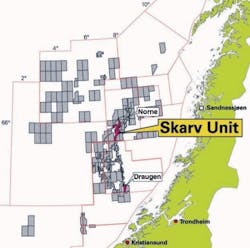The X factor
Peter Howard Wertheim - Contributing Editor
Founded just two years ago, the Brazilian oil company OGX Petróleo e Gás Participações already reports indications of hydrocarbons in two of the 22 high-potential exploration blocks it owns offshore Brazil.
In October this year, OGX announced that well 1-MRK-2A-SPS revealed traces of oil in the shallow waters of Santos basin in the BM-S-29 block. OGX holds a 65% working interest in this concession and Maersk Oil, the operator, 35%.
Three days later, OGX announced the presence of oil in the shallow waters of the southern part of the Campos basin in well 1-OGX-1-RJS, drilled in the BM-C-43 block. OGX holds a 100% working interest in this block.
OGX is notable for its entirely Brazilian composition. Like national oil company Petrobras, where OGX found and recruited its engineering talent, Brazil’s largest independent views the booming local oil and gas industry with national pride.
“OGX’s success is the proof that it is worthwhile investing on talent of the Brazilian people as well as on the richness and abundance of our natural resources. These recent discoveries will contribute to a robust economic growth and bring greater social justice,” Eike Batista, OGX’s founder and principal shareholder, tellsOffshore magazine.
Founded in July 2007, OGX has become the largest privately owned oil company in the petroleum sector in Brazil, with rights to explore 7,000 sq km (8,417 sq mi) offshore, second only to Petrobras, and 21,800 sq km (2.703 sq mi) onshore including blocks recently acquired.
All but one of the 22 areas owned by OGX were acquired at auction in November 2007. It was an eye-catching start: the 21 blocks were acquired for $797 million, with a record-setting bid for a single block of around $185 million. With over $4 billion raised in its IPO, the company is investing heavily, with $2 billion already set aside for its exploratory campaign.
The dramatic arrival of OGX follows a history of similar undertakings by Batista’s holding company, the EBX Group. Considered Brazil’s wealthiest individual, Eike Batista is one of Brazil’s most successful entrepreneurs, founding companies in electricity (MPX), mining (MMX), logistics (LLX), entertainment, and real estate. Each venture carries Batista’s trademark: letter “X”.
“The ‘X’ in all these companies’ names represents multiplication. Enterprises need to have the capacity to generate wealth and multiply their own value for their employees, for investors, and for society,” Batista says of the moniker.
Analysts attribute OGX’s fund raising success to the fact that Batista saw opportunity in Brazil’s massive potential, and acted quickly to snap up 29 offshore blocks in five different basins. Some of these are in deepwater and others in shallow plays, including five blocks in Santos.
Forbes magazine in March pegged Batista’s fortune at $7.5 billion, placing him 61st on the list of the world’s wealthiest individuals. Today, Batista is worth more than $20 billion, courtesy of a 64% run-up in the stock of OGX, as well as valuation gains in other holdings. And he is gunning to become the world’s richest man.
For Paulo Mendonça, OGX’s general executive manager and E&P director, the rapid pace of discoveries is a consequence of the dedication of the company’s unique technical team. It is no secret that Eike Batista built his team with deep pockets, hiring some of the best professionals in Brazil from other prominent posts, including the highest echelons of Petrobras.
Mendonça himself is well known in Brazil, having been head of the Petrobras Exploration Division from 2002 to 2007, at a time when Brazil shocked the world with its massive discovery of pre-salt hydrocarbons. The 34-year veteran of Petrobras also served as general manager of the Petrobras E&P Sergipe-Alagoas business unit, general manager of the Petrobras E&P in Colombia, and similar positions managing exploration in the Americas and the Middle East.
Mendonça is one of a number of engineers selectively recruited from Brazil’s national oil giant. As well, OGX has acquired a management team among the most experienced in the Brazilian energy industry, with a board of directors that includes two former energy ministers, one former finance minister, and one former president of Petrobras.
The resulting “A-list” under the command of Batista is considered to be one of the driving factors for the newcomer’s success.
Santos and Campos, with an X
Batista’s strategy of paying a premium for recruitment appears to be paying off. In October, the company announced drilling had been completed on well 1-OGX-1-RJS, in block BM-C-43, in the shallow waters of the southern part of the Campos basin.
The well was drilled to 2,347 m (7,700 ft) in 140 m (459 ft) of water. Initiated in September, the drilling of this well encountered an oil column of over 200 m (656 ft) and sandy reservoirs (net pay) of 57 m (187 ft).
Oil samples were taken and sent for analysis in order to determine the oil characteristics. Based on the well information and existing 3D seismic data interpretation, OGX estimates a recoverable oil volume of between 500 MMbbl and 1.5 Bbbl.
“These excellent results highlight the high petrolific potential of our blocks and contribute to the reduction of exploratory risk on our upcoming prospects to be drilled in the region,” says Mendonça. “The conclusion of activities on this well in less than a month demonstrates our team’s commitment to executing our business plan deftly, while optimizing our financial resources.”
The rig,Ocean Ambassador, used for this well, will be mobilized to the next location, well 1-OGX-2-RJS, in block BM-C-41, in the shallow waters of southern Campos basin.
“These findings in Brazil’s most promising basins represent an important achievement for OGX,” says Mendonça. “The drilling of well 1-MRK-2A-SPS is still in progress and the gathering of additional data will be necessary to determine the significance of the samples.”
Mendonça, who also serves as OGX’s chief geologist, expects large discoveries in the Santos basin where OGX and partner Maersk Oil have just started drilling. “There will be a huge amount of discoveries announced in Santos,” Mendonça says.
The 1-MRK-2A-SPS well is 130 km (81 mi) off the coast of São Paulo state at a water depth of 100 m (328 ft). Transocean’sSovereign Explorer initiated drilling in mid-August.
Mendonça tellsOffshore that first production in the Campos basin is expected by 2011. Peak production could reach 890,000 b/d by 2019.
Hopes are high once again for the Campos basin, after the discovery of pre-salt hydrocarbons by Anadarko in deepwater block BM-C-30 and OGX’s progress toward the Vesúvio prospect in BM-C-43 in shallow waters.
“1-OGX-1 marks the beginning of a highly promising exploratory campaign. The success of this well confirms our positive expectations of the prolific potential of the southern part of Campos basin and paves the way to unveil the Vesúvio Complex and other objectives in our blocks,” says Mendonça
Stirrings of a giant
In 2008, OGX spent $68 million to survey and process seismic data from Campos, Santos, Espírito Santo, and Pará-Maranhão basins. Since then, OGX has completed seismic acquisition in all its blocks and has begun data interpretation, which, according to Batista, confirms earlier models.
“It is important to say the seismic results we are receiving are validating the geological model that we had envisioned when we purchased our blocks in the first place,” Batista says. “That means that we are able to see what we expected to see.”
In March, OGX hired DeGolyer & MacNaughton (D&M) to prepare an independent evaluation of the exploratory portfolio. A new study was about to be launched by D&M at press time. The results are expected to show an increase based on inclusion of more recent seismic data.
The earlier report by D&M indicated that the blocks in Campos, Santos, Espírito Santo, and Pará-Maranhão basins contained 4.8 Bboe of net risked prospective resources, assuming an exploratory success probability of 27%. However, OGX thinks the success rate could be closer to 50%, which would have a dramatic impact on estimated reserves.
Mendonça points out that independent certification by D&M of volume estimates already mapped by OGX’s geologists and geophysicists provides greater confidence in the company’s reservoir models.
According to OGX’s estimates, the 51 prospects mapped and to be drilled between 2009 and 2012 have a total potential volume of oil and gas resources in the range of 20.2 Bboe. If the stakes owned by OGX’s partners are excluded, the Brazilian independent has potential reserves of 17.6 Bboe. In comparison, some analysts predict that pre-salt volumes offshore Brazil could reach 100 Bboe.
Whether the dizzying potential of these reserves will continue to unfold depends on more data about the reservoirs becoming known. The news so far, however, has been very sweet indeed.
According to Mendonça, the areas owned jointly with Perenco in Espírito Santo may have geological structures similar to those of the Golfinho field operated by Petrobras. The Espírito Santo basin is off the Atlantic coast north of Vitoria, capital of Espírito Santo state, about 450 km (280 mi) northeast of Rio de Janeiro.
The importance of this field is that Petrobras already has discovered light crude in Golfinho, with estimated reserves of 600 MMbbl. The field currently produces from 60,000 to 70,000 b/d and peak production is estimated at 100,000 b/d of oil and 3.5 MMcm/d (123.6 MMcf/d) of gas.
In the Para-Maranhão basin, north of Brazil, the company expects to find light crude oil and natural gas. Since Brazilian refineries are configured for predominately heavy oil, large volumes of light oil would mean substantial export potential. “We expect much more light oil than gas,” says Mendonça.
Integrated support center
One of the company’s accomplishments in Brazil has been to develop an integrated well engineering, services, and operations system to provide round-the-clock support. OGX says this is the first such center in Latin America with integrated support from Schlumberger, M-I SWACO, and Geoservices.
With real-time access to all data from the rigs, the center allows specialists in interpretation and data evaluation, geologists, geophysicists, and engineers to participate in the drilling decisions from OGX headquarters.
Advancements in data transmission technology make it possible to ensure full support from a global network of experts and technical resources. Schlumberger, for instance, is connected to its offices in Houston and Gatwick, UK; M-I SWACO to its headquarters in Houston; and Geoservices to its Specialists Center in Paris.
“This new center provides essential support to OGX’s activities, ensuring agility in the decision making, reducing risks, and making our exploratory campaign even more precise and efficient,” says Mendonça.
“It is almost impossible for any company to have the most specialized people on different rigs simultaneously. Through this initiative, we have the best team in our headquarters, analyzing and interpreting data, with the support of our state-of-the art visualization center, which enables simulations and 3D analysis,” adds Reinaldo Belotti, production development director for OGX.
Domestic content
The first OGX production should begin in the shallow waters off Campos, where the company has stakes in seven blocks. The development project, to be executed by Technip, is designed to provide flexibility. That means that OGX, like its Brazilian counterpart Petrobras, will be using jackets and FPSOs in the shallow water fields to facilitate the export of oil without pipelines.
Although the company will not decide about new rigs until after the first wells are drilled, in order to reach peak production of 890,000 b/d by 2019, OGX expects to contract eight to 12 FPSOs, 15 jackets (some with drilling rigs) and four TLWPs during the next four years.
OGX has long-term contracts with four semisubmersible drilling rigs to conduct its four-year exploratory drilling campaign. This phase has a potential for up to 51 wells to be drilled in Santos, Campos, Espírito Santo, and Pará-Maranhão offshore basins.
“It’s a positive cycle. We are contracting equipment when the market is down, and we fully believe that we will be producing when the market is up,” says Belotti.
As with other operators, last year’s precipitous decline in oil prices forced a change in strategy. OGX had been negotiating with companies that build FPSOs on speculation prior to the crisis, because it never intended to operate its own units. However, now that the market is down, the company is revising its purchasing and building strategy.
Betting that demand for oil rigs and drilling ships will surge as the country taps billions of barrels of offshore crude, Batista’s EBX has created a holding company called OSX Oil Services. This new company, which plans to raise some $4 billion in a public offering, will enable OGX to meet domestic content requirements for offshore projects at the same time that Petrobras, with its own ambitious drilling program, is expected to rely on all available shipyard capacity in Brazil through 2018.
With an eye toward this surge in demand, Batista plans to spend $600 million to build his own shipyard for constructing platforms and offshore equipment. Construction of the shipyard is scheduled to begin in 2010 in Bigaçu, in the southern state of Santa Catarina.
Meanwhile, VetcoGray has signed a four-year frame agreement with OGX to supply subsea wellhead systems and casing strings for the offshore exploratory drilling. The agreement covers the supply of MS-700 and MS-800 subsea wellhead systems, including large bore casing strings, associated rental tools, and onshore and offshore assistance during the entire drilling campaign.
The wellheads and casing strings will be manufactured in Brazil.
Peter Howard Wertheim is an international journalist based in Rio de Janeiro. He can be contacted at:[email protected]




